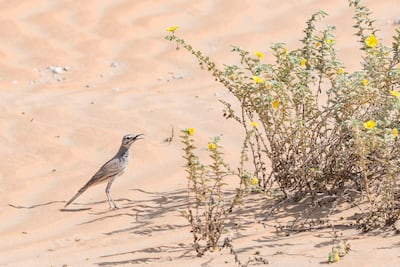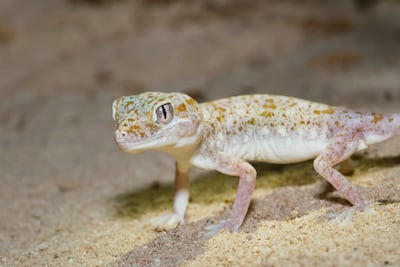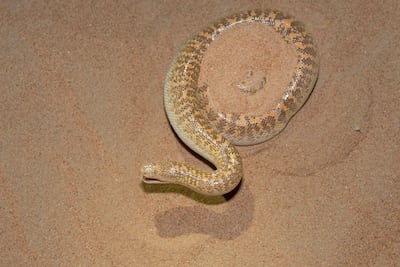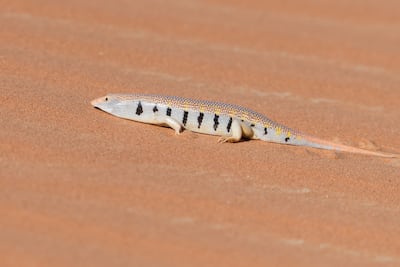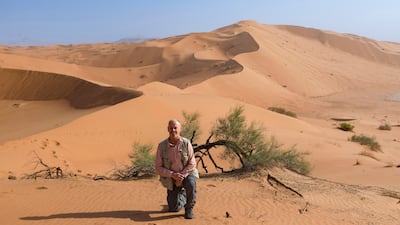The Rub’ Al Khali, or Empty Quarter, is often thought of as an area of endless sand dunes, a landscape that is striking but, as its name suggests, empty.
But those who have been there many times know that there is much more to the Empty Quarter than the cliché of nothingness, even if visitors may have to look a little harder than in other places to find features of interest.
In an extraordinary three-decade association with Arabia, Dr Gary Brown has made several visits to the sprawling Empty Quarter.
Thanks to his lengthy experience surveying the natural environment of Arabia, few could match Dr Brown’s ability to understand the unforgiving region, which lies in the UAE, Saudi Arabia, Oman and Yemen. The Briton most recently went deep into the area earlier this year.
Being in the Empty Quarter, which, depending on how it is defined, can cover as much as 650,000 square kilometres – an area bigger than France or Ukraine – is, Dr Brown, 66, said, “a very spiritual experience”.
“On the whole it’s a very remote place,” he said. “If you go into the dunes you can more or less guarantee nobody’s been there.
A place of wonder
“It’s still the same as ever, in many places untouched. In some ways you could call many parts of it true wilderness. There is no wilderness left in Europe any more – everything’s been touched by humans in some form or other. Down there you could say it’s true wilderness.
“It’s a huge area. No roads or anything in there, just a few tracks here and there. If you want to get around in there, you have to be self-sufficient. That means taking everything with you.
“You don’t go there by yourself, it’s just not feasible … By yourself it would be far too dangerous because if you do break down, nobody’s going to find you for days.”
It is, he said, “the largest sand sea in the world”, but it is not all sand dunes, as there are also large areas of salt-rich plains.
Nature takes root in the desert
While these plains typically lack plant life, on the sand dunes vegetation may be found even in the depths of the Empty Quarter because sand is “a very good medium for plant growth”.
“In an arid climate, the rain passes through the sand pretty quickly, through the surface layers, but it’s held in the subsurface and plants with deep roots can access this,” Dr Brown said.
“The Bedouins knew this – this is why they always followed the rain for grazing. It’s what they used to do when they were nomads. The camels could smell rain from a long way away – I think from 30 to 40km away and they [the Bedouins] followed the camels and headed to where it rained.
“After a couple of weeks the green starts coming up, grasses come up, sedges come up and in the northern part of the Empty Quarter, the annuals come up, which are very good for grazing.”
While there are no trees in the Empty Quarter – even the hardy ghaf tree found in the UAE cannot cope with the harsh conditions, Dr Brown found about a dozen perennial plant species – species that exist for several years – during his most recent trip. However, there were very few desert annual species.
“I think there are two or three [annual plant] species. If you go to a place like Kuwait you find a couple of hundred [annual plant] species,” he said.
“You can see lots of vegetation in some parts of the Empty Quarter, but it’s salt bush, Zygophyllum. It’s perfectly natural, it’s just that nothing very much eats it, camels don’t like it.”
The wettest parts of the Empty Quarter probably get, Dr Brown said, less than 30mm of rain a year – about a third or less of the amount in most coastal areas of the UAE.
Wildlife thrives at night
There is, he said, little animal life to see during the day, although creatures such as skinks or sandfish can sometimes be spotted, but Dr Brown said they dive rapidly into the sand when a person comes near.
“All the activity’s at night or a lot of it is,” he said. “We camped down there recently on our trip. If you get up in the morning you see all these footprints – gerbils, jerboas. I think it was Ruppell's Fox we saw during the day.”
On his latest trip, Dr Brown had an uninvited guest in his sleeping bag – a camel spider. These creatures, which are arachnids but are not actually spiders, can give a nasty bite to people and although not venomous, are capable of killing rodents and small birds, among other creatures.
Dr Brown’s other work on the Arabian Peninsula has been no less interesting than his adventures in and around the Empty Quarter, an area he first visited in 2005.
Originally from Nottingham in central England, as a child Dr Brown moved to Germany, where he completed a PhD before carrying out biodiversity surveys for regional governments.
Then, almost exactly 30 years ago, he moved to the Middle East to teach botany at Kuwait University.
He undertook detailed surveys of the natural environment and, after moving back to Germany, was awarded a higher degree for his work on the vegetation of north-eastern Arabia, particularly Kuwait.
Dr Brown later lived in Abu Dhabi for more than three years, working for the Environmental Research and Wildlife Development Agency, the forerunner of the Environment Agency – Abu Dhabi, a period during which he got to see almost every corner of the Emirates.
Other work included spells helping with desert restoration efforts in Kuwait long after the first Gulf War and, from 2010, a university role teaching botany in Oman, which allowed him to travel widely surveying the country’s natural environment.
Although now living back in Germany, he travels to the region regularly as a consultant to help with land resource management, environmental assessments and conservation.
On September 22, he will give a talk on the Empty Quarter to the Dubai Natural History Group.
Although the Empty Quarter is one of the world’s few remaining wildernesses, it is not devoid of human influence.
Delving into desolate lands
A village in the southern part, Thabhloten, which lies in Saudi Arabia not far from the Omani border, is among the most remote settlements in Arabia and was visited by the British explorer Wilfred Thesiger, who famously travelled through the Empty Quarter.
While covering only a tiny fraction of the land area of the Empty Quarter, there are also oil and gas developments, some of which have provided surprising benefits to birdlife in the area.
“Oil companies have created their own lakes from oil exploration,” he said. “There are one or two lakes down there, artificial lakes, which depending on the time of year are wet or dry.
“[There is] lots of birdlife. You’d be surprised what turns up in these artificial wetlands but also natural ones … there are springs.”
Among the birds Dr Brown has seen in the Empty Quarter is the hoopoe-lark, one of the few resident avians. A migratory species that passes through is the bluethroat, an attractive insectivorous wetland bird of countries including the United Kingdom. Dr Brown has spotted ducks, waders and harriers.
“[Migratory birds] tend to avoid the Empty Quarter if they can, but it’s not always possible. I suppose they might learn that there are wetlands there,” he said.
“The water’s brackish in some places, so it’s probably not too good to drink, but there are reed beds there for them to hide in.”
So, despite its reputation as a vast emptiness, for experts such as Gary Brown, Rub’ Al Khali offers plenty to see.
New UK refugee system
- A new “core protection” for refugees moving from permanent to a more basic, temporary protection
- Shortened leave to remain - refugees will receive 30 months instead of five years
- A longer path to settlement with no indefinite settled status until a refugee has spent 20 years in Britain
- To encourage refugees to integrate the government will encourage them to out of the core protection route wherever possible.
- Under core protection there will be no automatic right to family reunion
- Refugees will have a reduced right to public funds
COMPANY%20PROFILE
%3Cp%3E%3Cstrong%3ECompany%20name%3A%3C%2Fstrong%3E%20Alaan%3Cbr%3E%3Cstrong%3EStarted%3A%3C%2Fstrong%3E%202021%3Cbr%3E%3Cstrong%3EBased%3A%3C%2Fstrong%3E%20Dubai%3Cbr%3E%3Cstrong%3EFounders%3A%3C%2Fstrong%3E%20Parthi%20Duraisamy%20and%20Karun%20Kurien%3Cbr%3E%3Cstrong%3ESector%3A%3C%2Fstrong%3E%20FinTech%3Cbr%3E%3Cstrong%3EInvestment%20stage%3A%3C%2Fstrong%3E%20%247%20million%20raised%20in%20total%20%E2%80%94%20%242.5%20million%20in%20a%20seed%20round%20and%20%244.5%20million%20in%20a%20pre-series%20A%20round%3Cbr%3E%3Cbr%3E%3C%2Fp%3E%0A
Biog
Mr Kandhari is legally authorised to conduct marriages in the gurdwara
He has officiated weddings of Sikhs and people of different faiths from Malaysia, Sri Lanka, Russia, the US and Canada
Father of two sons, grandfather of six
Plays golf once a week
Enjoys trying new holiday destinations with his wife and family
Walks for an hour every morning
Completed a Bachelor of Commerce degree in Loyola College, Chennai, India
2019 is a milestone because he completes 50 years in business
Gender equality in the workplace still 200 years away
It will take centuries to achieve gender parity in workplaces around the globe, according to a December report from the World Economic Forum.
The WEF study said there had been some improvements in wage equality in 2018 compared to 2017, when the global gender gap widened for the first time in a decade.
But it warned that these were offset by declining representation of women in politics, coupled with greater inequality in their access to health and education.
At current rates, the global gender gap across a range of areas will not close for another 108 years, while it is expected to take 202 years to close the workplace gap, WEF found.
The Geneva-based organisation's annual report tracked disparities between the sexes in 149 countries across four areas: education, health, economic opportunity and political empowerment.
After years of advances in education, health and political representation, women registered setbacks in all three areas this year, WEF said.
Only in the area of economic opportunity did the gender gap narrow somewhat, although there is not much to celebrate, with the global wage gap narrowing to nearly 51 per cent.
And the number of women in leadership roles has risen to 34 per cent globally, WEF said.
At the same time, the report showed there are now proportionately fewer women than men participating in the workforce, suggesting that automation is having a disproportionate impact on jobs traditionally performed by women.
And women are significantly under-represented in growing areas of employment that require science, technology, engineering and mathematics skills, WEF said.
* Agence France Presse
Avengers: Endgame
Directors: Anthony Russo, Joe Russo
Starring: Robert Downey Jr, Chris Evans, Scarlett Johansson, Chris Hemsworth, Josh Brolin
4/5 stars
Full list of brands available for Instagram Checkout
Adidas @adidaswomen
Anastasia Beverly Hills @anastasiabeverlyhills
Balmain @balmain
Burberry @burberry
ColourPop @colourpopcosmetics
Dior @dior
H&M @hm
Huda Beauty @hudabeautyshop
KKW @kkwbeauty
Kylie Cosmetics @kyliecosmetics
MAC Cosmetics @maccosmetics
Michael Kors @michaelkors
NARS @narsissist
Nike @niketraining & @nikewomen
NYX Cosmetics @nyxcosmetics
Oscar de la Renta @oscardelarenta
Ouai Hair @theouai
Outdoor Voices @outdoorvoices
Prada @prada
Revolve @revolve
Uniqlo @uniqlo
Warby Parker @warbyparker
Zara @zara
Keep it fun and engaging
Stuart Ritchie, director of wealth advice at AES International, says children cannot learn something overnight, so it helps to have a fun routine that keeps them engaged and interested.
“I explain to my daughter that the money I draw from an ATM or the money on my bank card doesn’t just magically appear – it’s money I have earned from my job. I show her how this works by giving her little chores around the house so she can earn pocket money,” says Mr Ritchie.
His daughter is allowed to spend half of her pocket money, while the other half goes into a bank account. When this money hits a certain milestone, Mr Ritchie rewards his daughter with a small lump sum.
He also recommends books that teach the importance of money management for children, such as The Squirrel Manifesto by Ric Edelman and Jean Edelman.
Living in...
This article is part of a guide on where to live in the UAE. Our reporters will profile some of the country’s most desirable districts, provide an estimate of rental prices and introduce you to some of the residents who call each area home.
The specs
Engine: 2x201bhp AC Permanent-magnetic electric
Transmission: n/a
Power: 402bhp
Torque: 659Nm
Price estimate: Dh200,000
On sale: Q3 2022
3%20Body%20Problem
%3Cp%3E%3Cstrong%3ECreators%3A%3C%2Fstrong%3E%20David%20Benioff%2C%20D%20B%20Weiss%2C%20Alexander%20Woo%3C%2Fp%3E%0A%3Cp%3E%3Cstrong%3EStarring%3A%20%3C%2Fstrong%3EBenedict%20Wong%2C%20Jess%20Hong%2C%20Jovan%20Adepo%2C%20Eiza%20Gonzalez%2C%20John%20Bradley%2C%20Alex%20Sharp%3C%2Fp%3E%0A%3Cp%3E%3Cstrong%3ERating%3A%3C%2Fstrong%3E%203%2F5%3C%2Fp%3E%0A
Greatest of All Time
Starring: Vijay, Sneha, Prashanth, Prabhu Deva, Mohan
The%20specs
%3Cp%3E%3Cstrong%3EEngine%3A%3C%2Fstrong%3E%20Dual%20synchronous%20electric%20motors%0D%3Cbr%3E%3Cstrong%3EPower%3A%20%3C%2Fstrong%3E660hp%0D%3Cbr%3E%3Cstrong%3ETorque%3A%20%3C%2Fstrong%3E1%2C100Nm%0D%3Cbr%3E%3Cstrong%3ETransmission%3A%20%3C%2Fstrong%3ESingle-speed%20automatic%0D%3Cbr%3E%3Cstrong%3ETouring%20range%3A%20%3C%2Fstrong%3E488km-560km%0D%3Cbr%3E%3Cstrong%3EPrice%3A%20%3C%2Fstrong%3EFrom%20Dh850%2C000%20(estimate)%0D%3Cbr%3E%3Cstrong%3EOn%20sale%3A%20%3C%2Fstrong%3EOctober%3C%2Fp%3E%0A
Huddersfield Town permanent signings:
- Steve Mounie (striker): signed from Montpellier for £11 million
- Tom Ince (winger): signed from Derby County for £7.7m
- Aaron Mooy (midfielder): signed from Manchester City for £7.7m
- Laurent Depoitre (striker): signed from Porto for £3.4m
- Scott Malone (defender): signed from Fulham for £3.3m
- Zanka (defender): signed from Copenhagen for £2.3m
- Elias Kachunga (winger): signed for Ingolstadt for £1.1m
- Danny WIlliams (midfielder): signed from Reading on a free transfer
Gothia Cup 2025
4,872 matches
1,942 teams
116 pitches
76 nations
26 UAE teams
15 Lebanese teams
2 Kuwaiti teams
Business Insights
- As per the document, there are six filing options, including choosing to report on a realisation basis and transitional rules for pre-tax period gains or losses.
- SMEs with revenue below Dh3 million per annum can opt for transitional relief until 2026, treating them as having no taxable income.
- Larger entities have specific provisions for asset and liability movements, business restructuring, and handling foreign permanent establishments.
Diriyah%20project%20at%20a%20glance
%3Cp%3E-%20Diriyah%E2%80%99s%201.9km%20King%20Salman%20Boulevard%2C%20a%20Parisian%20Champs-Elysees-inspired%20avenue%2C%20is%20scheduled%20for%20completion%20in%202028%0D%3Cbr%3E-%20The%20Royal%20Diriyah%20Opera%20House%20is%20expected%20to%20be%20completed%20in%20four%20years%0D%3Cbr%3E-%20Diriyah%E2%80%99s%20first%20of%2042%20hotels%2C%20the%20Bab%20Samhan%20hotel%2C%20will%20open%20in%20the%20first%20quarter%20of%202024%0D%3Cbr%3E-%20On%20completion%20in%202030%2C%20the%20Diriyah%20project%20is%20forecast%20to%20accommodate%20more%20than%20100%2C000%20people%0D%3Cbr%3E-%20The%20%2463.2%20billion%20Diriyah%20project%20will%20contribute%20%247.2%20billion%20to%20the%20kingdom%E2%80%99s%20GDP%0D%3Cbr%3E-%20It%20will%20create%20more%20than%20178%2C000%20jobs%20and%20aims%20to%20attract%20more%20than%2050%20million%20visits%20a%20year%0D%3Cbr%3E-%20About%202%2C000%20people%20work%20for%20the%20Diriyah%20Company%2C%20with%20more%20than%2086%20per%20cent%20being%20Saudi%20citizens%0D%3C%2Fp%3E%0A
The%20Hunger%20Games%3A%20The%20Ballad%20of%20Songbirds%20%26%20Snakes
%3Cp%3E%3Cstrong%3EDirector%3A%3C%2Fstrong%3E%C2%A0Francis%20Lawrence%3C%2Fp%3E%0A%3Cp%3E%3Cstrong%3EStars%3A%C2%A0%3C%2Fstrong%3ERachel%20Zegler%2C%20Peter%20Dinklage%2C%20Viola%20Davis%2C%20Tom%20Blyth%3C%2Fp%3E%0A%3Cp%3E%3Cstrong%3ERating%3A%20%3C%2Fstrong%3E3%2F5%3C%2Fp%3E%0A
THE CLOWN OF GAZA
Director: Abdulrahman Sabbah
Starring: Alaa Meqdad
Rating: 4/5
Who has been sanctioned?
Daniella Weiss and Nachala
Described as 'the grandmother of the settler movement', she has encouraged the expansion of settlements for decades. The 79 year old leads radical settler movement Nachala, whose aim is for Israel to annex Gaza and the occupied West Bank, where it helps settlers built outposts.
Harel Libi & Libi Construction and Infrastructure
Libi has been involved in threatening and perpetuating acts of aggression and violence against Palestinians. His firm has provided logistical and financial support for the establishment of illegal outposts.
Zohar Sabah
Runs a settler outpost named Zohar’s Farm and has previously faced charges of violence against Palestinians. He was indicted by Israel’s State Attorney’s Office in September for allegedly participating in a violent attack against Palestinians and activists in the West Bank village of Muarrajat.
Coco’s Farm and Neria’s Farm
These are illegal outposts in the West Bank, which are at the vanguard of the settler movement. According to the UK, they are associated with people who have been involved in enabling, inciting, promoting or providing support for activities that amount to “serious abuse”.
Results
5pm: UAE Martyrs Cup (TB) Conditions Dh90,000 2,200m
Winner: Mudaarab, Jim Crowley (jockey), Erwan Charpy (trainer).
5.30pm: Wathba Stallions Cup (PA) Handicap Dh70,000 1,400m
Winner: Jawal Al Reef, Richard Mullen, Hassan Al Hammadi.
6pm: UAE Matyrs Trophy (PA) Maiden Dh80,000 1,600m
Winner: Salima Al Reef, Jesus Rosales, Abdallah Al Hammadi.
6.30pm: Sheikha Fatima bint Mubarak (IFAHR) Apprentice Championship (PA) Prestige Dh100,000 1,600m
Winner: Bainoona, Ricardo Iacopini, Eric Lemartinel.
7pm: Sheikha Fatima bint Mubarak (IFAHR) Ladies World Championship (PA) Prestige Dh125,000 1,600m
Winner: Assyad, Victoria Larsen, Eric Lemartinel.
8pm: Sheikh Zayed bin Sultan Al Nahyan Jewel Crown (PA) Group 1 Dh5,000,000 1,600m
Winner: Mashhur Al Khalediah, Jean-Bernard Eyquem, Phillip Collington.
UFC Fight Night 2
1am – Early prelims
2am – Prelims
4am-7am – Main card
7:30am-9am – press cons
Yahya Al Ghassani's bio
Date of birth: April 18, 1998
Playing position: Winger
Clubs: 2015-2017 – Al Ahli Dubai; March-June 2018 – Paris FC; August – Al Wahda
What are the influencer academy modules?
- Mastery of audio-visual content creation.
- Cinematography, shots and movement.
- All aspects of post-production.
- Emerging technologies and VFX with AI and CGI.
- Understanding of marketing objectives and audience engagement.
- Tourism industry knowledge.
- Professional ethics.
AI traffic lights to ease congestion at seven points to Sheikh Zayed bin Sultan Street
The seven points are:
Shakhbout bin Sultan Street
Dhafeer Street
Hadbat Al Ghubainah Street (outbound)
Salama bint Butti Street
Al Dhafra Street
Rabdan Street
Umm Yifina Street exit (inbound)
